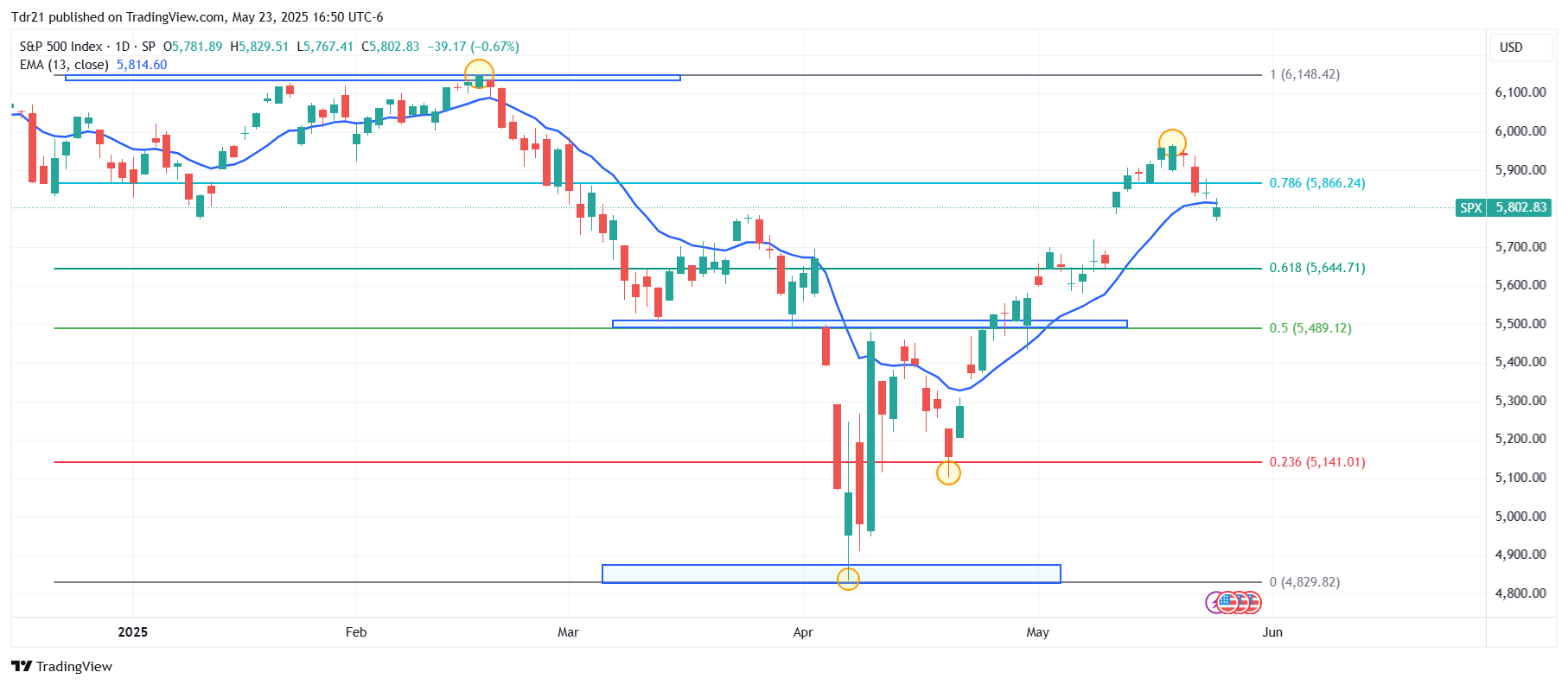- The S&P 500 share index falls 0.65% on Friday, visiting May 12 at 5,742.
- The actions of Deckers Outdoor Corporation (Deck) collapse 19.86% today, reaching minimums not seen since April 4 at $ 96.10.
- The president of the United States, Donald Trump, recommends a 50% tariff to the European Union, increasing commercial tensions.
- Alberto Musalem, president of the St. Louis Federal Reserve, highlighting commercial uncertainty, showing its concern to a general increase in medium -term prices.
The S&P 500 registered a maximum of the day in 5,854, where it found vendors that took the index to minimum of May 12 in 5,742. Currently, the S&P quotes at 5,800, losing 0.65% on the last day of the week.
The S&P 500 extends its fall after the increase in commercial tensions between the US and the European Union
Through a publication in the social network Truth Social, the president of the United States, Donald Trump, mentioned that he is recommending the imposition of a direct tariff of 50% to the European Union, effective as of June 1.
On the other hand, the President of the Federal Reserve of St. Louis, Alberto Musalem, mentioned in his speech today, that business leaders are increasingly concerned about economic consequences in the face of the general increase in prices and commercial uncertainty, showing their concern about inflationary expectations towards the long term.
In this context, the S&P 500 falls 38 points, signing its fourth consecutive day down, in tune with the main stock market rates. The actions of Deckers Outdoor Corporation (Deck), lead the falls in S&P 500, losing 19.86%, visiting minimal not seen since April 4 at 96.10 $.
Levels to be considered in the S&P 500
The S&P 500 established a short -term resistance in 5,967, maximum of May 19. The next key resistance is located in 6,145, Maximum of February 19. To the south, the important support is observed in 5,109, pivot point of April 21.
S&P 500 DAILY GRAPH

S&P 500 FAQS
The S&P 500 is a very often stock index that measures the yield of 500 public companies and is considered a wide measure of the US stock market. The influence of each company on the calculation of the index is weighted based on stock capitalization. This is calculated by multiplying the number of bought shares of the company for the price of the action. The S&P 500 index has achieved impressive yields: 1.00 $ invested in 1970 would have produced a yield of almost $ 192.00 in 2022. The average annual profitability since its creation in 1957 has been 11.9%.
Companies are selected by committee, unlike other indices included in established standards. Even so, they must fulfill certain eligibility criteria, the most important of which is stock market, which must be equal to or greater than 12.7 billion dollars. Other criteria are liquidity, domicile, stock capitalization, sector, financial viability, quotation time and representation of the sectors of the United States economy. The nine largest companies in the index represent 27.8% of the stock market capitalization.
There are several ways to operate with the S&P 500. Most of the Stred Betting retail runners and platforms allow operators to use contracts per difference (CFD) to make bets on the price direction. In addition, indexed funds, investment funds and quoted funds (ETF) that follow the price of the S&P 500 can be purchased. The most ETF liquid is the ETF of the London Stock Exchange. The most ETF liquid is the State Street Corporation Spy. The Chicago Mercantile Exchange (CME) offers futures contracts on the index and the Chicago Board of Options (CMOE) offers options, as well as ETF, ETF Inverse and ETF leverage.
There are many factors that promote S&P 500, but mainly it is the aggregate performance of the companies that compose it, revealed in their reports of quarterly and annual results. American and world macroeconomic data also contribute, since they influence investors’ confidence, which is positive drives profits. The level of interest rates, set by the Federal Reserve (FED), also influences the S&P 500, since it affects the cost of credit, which is largely depending on many companies. Therefore, inflation can be a determining factor, as well as other parameters that influence the decisions of the Federal Reserve.
Source: Fx Street
I am Joshua Winder, a senior-level journalist and editor at World Stock Market. I specialize in covering news related to the stock market and economic trends. With more than 8 years of experience in this field, I have become an expert in financial reporting.





